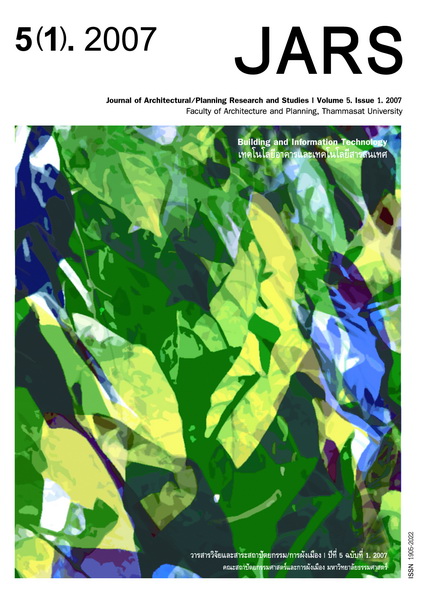Effect of Natural Materials on Properties of Adobe Brick for Earth Construction
Main Article Content
Abstract
The objective of this research was to study the influence of agricultural waste, such as rice husk
and coconut fiber on the properties of adobe bricks including compressive strength, drying shrinkage and
thermal properties. Two different types of clays were used for mixing adobe bricks. The percentage replacement
of the agricultural fibers in adobe bricks were 0, 1, 2, 3, 6 and 9% by weight respectively. The adobe bricks
were dried by using 2 methods, sun-drying for 7 days and oven-drying for 24 hours after sun-dried. From
test results, rice husk and coconut fiber can increase the compressive strength, and reduce the drying
shrinkage of adobe bricks. But increasing the percentage replacement of rice husk more than 3% tends to
reduce the compressive strength of adobe bricks. After oven-dried, the compressive strength of all mixes
increased. Type 2 clay, having more sand content, yielded higher compressive strength and less shrinkage
compared with those of Type 1 clay. When the percentage replacement of rice husk increased, the thermal
conductivity of adobe bricks decreased. On the other hand, increasing the percentage replacement of
coconut fiber tends to increase the thermal conductivity of adobe bricks. For the optimal mixes, regarding
mechanical and thermal properties, Type 2 clay mixed with 3% of rice husk by weight yielded the compressive
strength of 24.9 kg/cm2, drying shrinkage of 10.5% and thermal conductivity of 0.7 W/m. K. The other mix
made from Type 2 clay with 9% of coconut fiber yielded the compressive strength of 29.2 kg/cm2, drying
shrinkage of 6.2% and thermal conductivity of 0.9 W/m. K. The results suggested that natural materials
such as rice husk and coconut fiber can be used in the mixes for producing adobe bricks, which are used
as the main structure of adobe house, and also improve mechanical and thermal properties. This is
beneficial for developing adobe house as an alternative architecture along with gaining public acceptance.
Downloads
Article Details

This work is licensed under a Creative Commons Attribution-NonCommercial-NoDerivatives 4.0 International License.
All material is licensed under the terms of the Creative Commons Attribution 4.0 International (CC-BY-NC-ND 4.0) License, unless otherwise stated. As such, authors are free to share, copy, and redistribute the material in any medium or format. The authors must give appropriate credit, provide a link to the license, and indicate if changes were made. The authors may do so in any reasonable manner, but not in any way that suggests the licensor endorses you or your use. The authors may not use the material for commercial purposes. If the authors remix, transform, or build upon the material, they may not distribute the modified material, unless permission is obtained from JARS. Final, accepted versions of the paper may be posted on third party repositories, provided appropriate acknowledgement to the original source is clearly noted.
References
ราชบดินทร์ บุญไชโย ธนา อุทัยภัตรากูร และไพริน พงษ์สุระ. (2545). บ้านดิน: แนะนำการสร้างบ้านดินเบื้องต้น. กรุงเทพฯ: สวนเงินมีมา.
Khedari, J., Watsanasathaporn, P., & Hirunlabh, J. (2005). Development of fibre-based soil-cement block with low thermal conductivity. Cement & Concrete Composites, 27, 111–119.
Bouhicha, M., Aouissi, F., & Kenai, S. (2005). Performance of composite soil reinforced with barley straw. Cement & Concrete Composites, 27, 617–621.
ดนัย นิลสกุล. (2546). การอนุรักษ์ตึกดินในอีสานใต้. วิทยานิพนธ์มหาบัณฑิต ภาควิชาสถาปัตยกรรมศาสตร์ คณะสถาปัตยกรรมศาสตร์ จุฬาลงกรณ์มหาวิทยาลัย.
กรมส่งเสริมคุณภาพสิ่งแวดล้อม กระทรวงทรัพยากรธรรมชาติและสิ่งแวดล้อม. (2549). ลักษณะสมบัติของดิน. สืบค้นจาก www.environnet.in.th
American Society for Testing and Materials. (2002). ASTM C39: Standard test method for compressive strength of cylindrical concrete specimens. Annual Book of ASTM Standard, Vol. 4.02. Philadephia.
American Society for Testing and Materials. (2002). ASTM C128: Standard test method for specific gravity and absorption of fine aggregate. Annual Book of ASTM Standard, Vol. 4.02. Philadephia.
American Society for Testing and Materials. (2002). ASTM D422: Standard test method for particlesize analysis of soils. Annual Book of ASTM Standard, Vol. 4.02. Philadephia.
American Society for Testing and Materials. (2002). ASTM D4318: Standard test method for liquid limit, plastic limit, and plasticity index of soil. Annual Book of ASTM Standard, Vol. 4.02. Philadephia.
เอก ช่อประดับ และอนุสรณ์ อินทรังษี. (2547). คุณสมบัติเชิงกายภาพของอิฐสามัญที่ทำจากดินเหนียวผสมแกลบ. เอกสารประกอบการประชุมวิชาการโยธาแห่งชาติ ครั้งที่ 9, วิศวกรรมสถานแห่งประเทศไทยในพระบรมราชูปถัมภ์.
Bouguerra, A., Ledhem, A., de, Barquin, F., Dheilly, R. M., & Queneudec, M. (1998). Effect of microstructure on the mechanical and thermal properties of lightweight concrete prepared from clay, cement, and wood aggregates. Cement and Concrete Research, 28(8), 1179–1190.
เหม หีบแก้ว. (2549). อิทธิพลของเถ้าชีวมวลต่อคุณสมบัติการกันความร้อนของปูนฉาบมวลเบา. วิทยานิพนธ์มหาบัณฑิต คณะสถาปัตยกรรมศาสตร์และการผังเมือง มหาวิทยาลัยธรรมศาสตร์.


